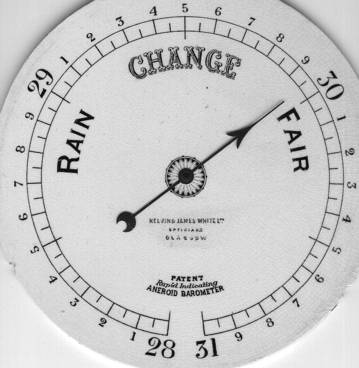 dial
illustrated. The needle on a barometer dial will not be zipping
backwards and forwards charting the progress of every fluctuation
of weather conditions as would be surmised from those fanciful
words !
dial
illustrated. The needle on a barometer dial will not be zipping
backwards and forwards charting the progress of every fluctuation
of weather conditions as would be surmised from those fanciful
words !The barometer dial ranges from '27' - '31' . These represent
inches of the fluid metal mercury in a glass tube as found in
a mercurial barometer. A more scientific scale ranges from '920'
- '1060' millibars, found in nautical barometers. The legends
: 'Rain, Change, Fair' etc. found on many dials are really decoration
only, as can be seen on this antique porcelain  dial
illustrated. The needle on a barometer dial will not be zipping
backwards and forwards charting the progress of every fluctuation
of weather conditions as would be surmised from those fanciful
words !
dial
illustrated. The needle on a barometer dial will not be zipping
backwards and forwards charting the progress of every fluctuation
of weather conditions as would be surmised from those fanciful
words !
Unfortunately, people who acquire an antique barometer, and the needle does not budge from one day to the next, assume that it must be broken, or stuck !
Before hanging on the wall, the barometer needle should be set approximately correctly for your locale using a barometer setting that is known to be accurate. In England, where I live, it is going to indicate somewhere between 29 and 30 just to the right of the centre line on 'Change' . There is a hole in the back of the wooden case for adjustment with a small screwdriver - a fraction less than one quarter turn should bring the needle to a suitable point , adjusted to your house's elevation above sea-level. You will not need to make this adjustment again unless you move home.
The barometer needle will indicate the changes in weather to be expected 24 hours ahead. It is therefore best used as a tool to predict the likelyhood of any change in the weather.
You will notice that in the centre of the glass, there is a second needle pointer that is simply attached to the glass alone with a knurled knob. It has no functional effect on the barometer mechanism itself. Its purpose is to be moved so that its pointer covers the active needle of the barometer itself. As the barometer needle may move from day to day, this indicating pointer may be adjusted to exactly shadow the progress on the dial of the active needle
It is this pointer that is so vital in showing that the barometer needle has changed for otherwise it would be necessary to remember mentally each tiny variation of the indicating needle. Using the pointer as a marker will show wether the pressure needle is going up, or down.
One way that it is possible to see if the pressure indicating needle is falling or rising is to tap the glass gently with a finger. The needle will be observed to move up or down by a minute fraction, showing which way the pressure is going.
Testing an aneroid barometer with a plastic bag :Take a transparent, airtight polythene bag large enough to contain the whole barometer, insert the aneroid barometer inside and roll up the open end or seal with sticky tape. Simply squeeze the sides of the bag increasing the air pressure inside the bag. The needle will go up inside the bag as you squeeze. If the needle does not move then this means that either the mechanism is broken, or worse, that the aneroid tube itself has lost its vacuum. Unfortunately, zinc can be attacked by a kind of creeping mould that eats through the aneroid cavity.
BACK TO MAIN INDEX PAGE
Copyright ©1997 IAN PARTRIDGE